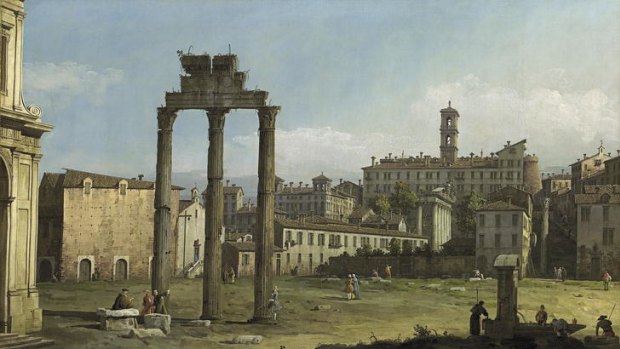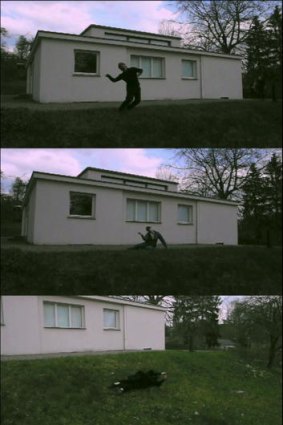By Robert Nelson
FACING EAST
Ausin Tung Gallery, 164 High St, Prahran, until June 2
IN SEARCH OF THE PICTURESQUE: THE ARCHITECTURAL RUIN IN ART
Geelong Gallery, Little Malop St, Geelong, until June 24

Bernardo Bellotto's Ruins of the Forum, Rome, c. 1743.
VISION IN MOTION
Narelle Jubelin, MUMA, until July 7
IN A lively exhibition at Ausin Tung Gallery, an image of eerie tranquillity arrested me. It's a large picture of the Great Wall of China. One of the rectangular bastions along the wall supports a swelling translucent dome, created with ice by the artist Wu Daxin.

Wu Daxin's Great Wall Project.
As if the ruin is not quite breathtaking enough, the awesome structure is capped with a fantasy, like Kubla Khan's "stately pleasure-dome" in Xanadu that the English poet Coleridge visualised in the 19th century.
Ruins inspire strange thoughts, from the sublime to the miserable. Ruins are a trace of broken majesty, recording the marvel of an earlier age together with its collapse. Because we know something before we stumble upon them, the ruins are more than debris that was never tidied: they're authoritative rubble, the wreckage of an august history that you might already approach with learned reverence, but is always ghosted by scholarly inadequacy.
A large and sumptuous exhibition at the Geelong Gallery curated by Colin Holden gathers paintings, prints, ceramics and photographs of ruins, many of which are Roman. The theme is updated with Australian ghost-town imagery, where the attraction is pathos and desolation rather than classical prestige. Looking at the works of Claude, Bellotto and Piranesi gives you the wobbles at the evocation of the Temple of Castor and Pollux, the Forum of Nerva, the Villa of Domitian or the Sibylline Temple at Tivoli. Apart from the rich atmospheric effects of the paintings or prints, the very names are enchanted with mysterious memories.
In the 1970s, the Florentine psychoanalyst Graziella Magherini coined the term Stendhal syndrome after observing the suffocating swoon that overcomes art-tourists. The term derives from the description of emotional transport by the French novelist Stendhal when he toured Italy in 1817.

Narelle Jubelin's Stendhal Syndrome, 2011.
It's getting harder and harder to experience Stendhal syndrome, because the volume of paying customers in Rome somewhat compromises the trance. The fractured columns still stand, just as in Bellotto's painting, and theoretically you can still indulge in the hallowed edifices of yore. Alas, both you and the temple seem to belong to a marketing strategy, and you end up thinking of economics more than the famous spirits who trod the marble in Roman sandals.
Is it stretching poetic credibility to imagine Stendhal syndrome with modernism? On this question, we get little but perplexity from a hilarious video by Narelle Jubelin called Stendhal syndrome. A substantial exhibition at Monash University reveals Jubelin's preoccupation with architectural history over a 28-year period; and much of it deals with the fragile mystique of modernism.
In Stendhal syndrome, four figures consecutively come around a house, have a fainting spell and tumble down a hillock. In one version, the vertiginous episodes are interspersed with the pages of an archival book on Bauhaus architecture. From such footnotes, we glean that the modest building is the Haus am Horn designed in 1923 by Georg Muche.
It isn't Muche's fault, but this minimal house -heralded as the first statement of architectural abstraction - speaks the same language as any fibro shack outside Bendigo. Even though Jubelin makes it look as burlesque as it sounds, it's still possible that the architectural devotee inspecting this bald relic would succumb to Stendhal syndrome.
The condition is hysterically induced by an overload of your greatest cultural fancy, whatever that may be. So if you're a passionate enthusiast of modernism, any original remnant on authentic ground may trigger the aesthetic shakes.
Jubelin keeps us guessing, from the early days of her delicate renditions of modernist architecture in petit point - so much lovelier than their subject matter - to her concern for the corporate styles overtaking our university campuses. It makes me wonder if modernist architecture will scrub up any better when it too becomes a ruin and can inspire history-hysteria in handsome decrepitude.
robert.nelson@monash.edu